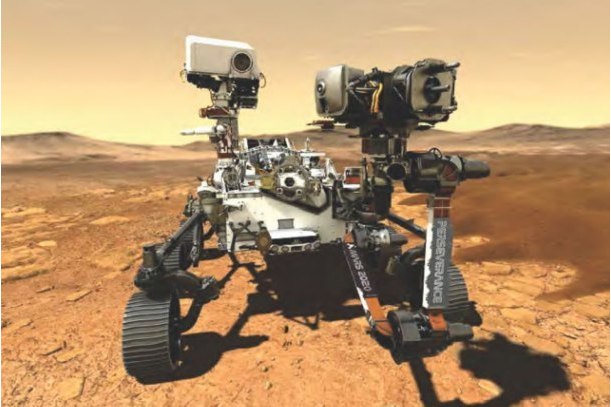Why Mars matters

Feature Highlight
We need humans to be able to live on Mars sustainably, responsibly, and safely.
The Perseverance rover, which landed on Mars last month, marks a new leap toward answering fundamental questions about our solar system, including where else we might find DNA. The rover will roam the surface of Mars looking for signs of life, make its own oxygen, launch a helicopter, and collect soil and rocks for a follow-up mission in 2028. If all goes as planned, NASA, with the help of European Space Agency (ESA) spacecraft, will return soil samples in the spring of 2032 – the first Martian material to visit Earth.
Finding DNA on Mars would not be a complete surprise. Though Perseverance was constructed in the Spacecraft Assembly Facility (SAF) clean room at NASA’s Jet Propulsion Laboratory (JPL), even that setting cannot be made 100% free of background microbial or human DNA. We have known about “microbial hitchhikers” since the very first interplanetary missions in the 1960s, when scientists such as Carl Sagan highlighted the problem. It is a persistent, unavoidable risk of space science. Because scientists must build the spacecraft one layer at a time, shedding skin and droplets of saliva over years of construction, it is almost certain that a little bit of California DNA just landed on Mars.
As such, when the samples arrive on Earth in 2032, they will need to go through a “planetary-scale genetic filter” to rule out any DNA that might have been present in the SAF during the rover’s construction from 2015-20, as well as any other fragment of DNA observed on Earth up until the launch of the spacecraft in July 2020. This is an ongoing project between our laboratory at Weill Cornell Medicine and JPL. By sequencing the DNA found in, around, and on the SAF during the construction of robots, we will draw up a genetic map to avoid or minimize any forward or backward contamination (where we send genetic material somewhere else, or genetic material from somewhere else lands here).
Ever since the first two Soviet probes landed on Mars’s surface in 1971, followed by the US Viking 1 landing in 1976, some fragments of microbial and possibly human DNA are likely to have ended up on the red planet. And given the planet’s global dust storms, this DNA is almost certainly located in various places across the surface.
Fortunately, we are living in an extraordinary era for genetics. The low cost of DNA sequencing allows us to build an ever-growing genetic catalog of life on Earth, genetic maps of SAF clean rooms, and the first-ever planetary-scale genome maps (MetaSUB and the Earth Microbiome Project). Moreover, in a 2016 mission with astronaut Kate Rubins, we showed that we can sequence DNA in space and match it to profiles of novel organisms on Earth. Anything that can survive in space, on spacecraft, or in extreme conditions on Earth is a decent candidate for life that can survive on Mars. Eventually, instead of sending DNA to Mars by accident, we will do it deliberately, for a purpose.
After all, manned missions to Mars are technologically achievable. They can bring out the best in humanity, and we already have the physical, pharmacological, and biological means to pursue them. In my new book, The Next 500 Years: Engineering Life to Reach New Worlds, I highlight studies that we performed on dozens of astronauts, including the twins Scott and (US Senator) Mark Kelly, following Scott’s one-year mission in space. Based on our findings, we are now confident that humans can travel to Mars, and with some additional innovation and technology, stay there.
We need humans to be able to live on Mars sustainably, responsibly, and safely not so that we can abandon Earth, but because the best way to ensure our species’ survival is to make it possible to live elsewhere. Mars is not Plan B: it is Plan A, and always has been.
We have an ethical duty to prevent our own species’ extinction as well as that of all others on Earth. No other species (that we know of) possesses such awareness of its potential future, nor the ability to preserve life. Only we can perform this function; and in the long term, doing so requires that we make our way to other planets. Settling Mars is the necessary first rung on the ladder of long-term survival (not least because Venus is too hot).
To meet this imperative, however, we will need to bring NASA’s budget back to 1960s levels, when it was 4.4% of the federal budget (compared to 0.48% today). We will need more international cooperation (including with China) as well. To that end, my colleagues and I recently published a series of papers and launched an international collaboration on aerospace medicine that includes representatives from NASA, ESA, ROSCOSMOS (Russia), and JAXA (Japan). The United Arab Emirates and others have also started studying space biology, and more space agencies are working with commercial platforms such as SpaceX and Blue Origin.
Some duties we choose for ourselves. But the duty to preserve life is inextricably bound up with the awareness of our own mortality and the possibility of extinction. Humanity’s stewardship of life is both a selfish imperative and an innate, unique obligation. By doing what it takes to preserve life as we know it, we may yet find new life in the universe.
Christopher E. Mason, a geneticist and computational biologist, is Associate Professor at Weill Cornell Medicine, with appointments at the Meyer Cancer Center, Memorial Sloan Kettering Cancer Center, the Information Society Project at Yale Law School, and the Consortium for Space Genetics at Harvard Medical School. His book The Next 500 Years: Engineering Life to Reach New Worlds will be published in April 2021. Copyright: Project Syndicate
Other Features
-
Can you earn consistently on Pocket Option? Myths vs. Facts breakdown
We decided to dispel some myths, and look squarely at the facts, based on trading principles and realistic ...
-
How much is a $100 Steam Gift Card in naira today?
2026 Complete Guide to Steam Card Rates, Best Platforms, and How to Sell Safely in Nigeria.
-
Trade-barrier analytics and their impact on Nigeria’s supply ...
Nigeria’s consumer economy is structurally exposed to global supply chain shocks due to deep import dependence ...
-
A short note on assessing market-creating opportunities
We have researched and determined a practical set of factors that funders can analyse when assessing market-creating ...
-
Rethinking inequality: What if it’s a feature, not a bug?
When the higher levels of a hierarchy enable the flourishing of the lower levels, prosperity expands from the roots ...
-
Are we in a financial bubble?
There are at least four ways to determine when a bubble is building in financial markets.
-
Powering financial inclusion across Africa with real-time digital ...
Nigeria is a leader in real-time digital payments, not only in Africa but globally also.
-
Analysis of NERC draft Net Billing Regulations 2025
The draft regulation represents a significant step towards integrating renewable energy at the distribution level of ...
-
The need for safeguards in using chatbots in education and healthcare
Without deliberate efforts the generative AI race could destabilise the very sectors it seeks to transform.
Most Popular News
- NDIC pledges support towards financial system stability
- Artificial intelligence can help to reduce youth unemployment in Africa – ...
- Afreximbank backs Elumelu’s Heirs Energies with $750-million facility
- AfDB and Nedbank Group sign funding partnership for housing and trade
- GlobalData identifies major market trends for 2026
- Lagride secures $100 million facility from UBA













